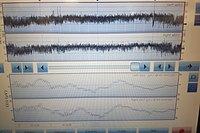
Photo from wikipedia
BACKGROUND We aimed to determine the predictive neurological prognostic value of early amplitude-integrated electroencephalography (aEEG) in term and near-term neonates with severe hyperbilirubinemia compared with cranial magnetic resonance imaging (MRI)… Click to show full abstract
BACKGROUND We aimed to determine the predictive neurological prognostic value of early amplitude-integrated electroencephalography (aEEG) in term and near-term neonates with severe hyperbilirubinemia compared with cranial magnetic resonance imaging (MRI) and auditory brainstem response (ABR). METHODS Infants of ≥35 weeks of gestation with severe hyperbilirubinemia (total serum bilirubin [TSB] ≥340 μmol/L) or with hyperbilirubinemia (TSB ≥257 μmol/L) in association with bilirubin-induced neurological dysfunction were recruited. All the subjects had an aEEG after being admitted to the neonatal intensive care unit, whereas cranial MRI and ABR were performed when TSB had come down to the normal range. All the infants were followed up to 12 months. RESULTS During the study period, 77 of 83 infants were eligible, of which 71 had severe hyperbilirubinemia and six had hyperbilirubinemia in association with bilirubin-induced neurological dysfunction. Thirty-three infants were diagnosed with acute bilirubin encephalopathy (ABE), two of whom died of ABE, and 62 completed the follow-up, of which 12 infants had adverse outcomes. Sixty-four infants underwent aEEG, 40 infants had cranial MRI, and 39 infants had ABR. Logistic regression and the receiver-operator characteristic curve analysis showed that the ability of severely abnormal aEEG to predict adverse neurological outcomes in severe hyperbilirubinemia was no better than abnormal ABR, with a sensitivity of 35.7% versus 83.3%, a specificity of 92.0% versus 74.1%, a positive predictive value of 55.6% versus 58.8%, and a negative predictive value of 83.6% versus 90.9%. CONCLUSIONS Early aEEG could predict adverse neurodevelopmental outcomes in neonates with severe hyperbilirubinemia, although the sensitivity was lower than ABR.
Journal Title: Pediatric neurology
Year Published: 2019
Link to full text (if available)
Share on Social Media: Sign Up to like & get
recommendations!